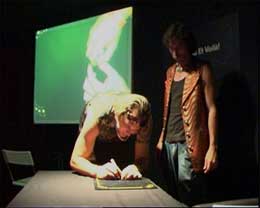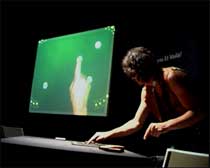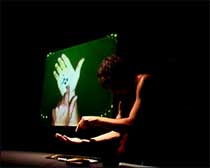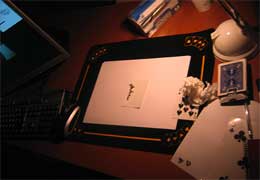 opensourcery is what you get when you throw a master of bewitching installations and a “real” magician right into a workshop dedicated to magic and illusion.
opensourcery is what you get when you throw a master of bewitching installations and a “real” magician right into a workshop dedicated to magic and illusion.
The workshop was Interactivos?, it took place in June at the MediaLab Madrid. The illusionists are Zachary Lieberman and Mago Julián (“Julian the Magician” in english.)
opensourcery is a performance which marries camera based technology with old fashioned close magic to manipulate a live video image seamlessly and create new tricks. The custom developed software is completely open-source (thus the title) and designed as a starting point for imagining a new language of tricks and techniques for magical expression.
A few questions to Zack:

 The coin follows the finger, then moves on its own + The magic eye reveals the chosen card
The coin follows the finger, then moves on its own + The magic eye reveals the chosen card
I suspect that it was the first time that you worked with a magician. How did the collaboration go? Did Mago Julián come with an idea asking for some technical help or did you develop the whole concept together? And did he teach you a few tricks you plan to use in your future work?
First of all the collaborate came out from the excellent advice of José Luis Vicente and Oscar Abril, two Sonar curators who noticed a similarity between how my performance Drawn works and how the magician Mago Julián uses an overhead camera to perform close magic.
It was the first time I’ve ever worked with a magician, and it was really surprising to see the differences in how we work and make work.
For example, magicians are very secretive about their techniques – it took a long time for Julián to warm up to showing me some of the “behind the scenes” while we were working together. I still have absolutely no idea how he does many of things he does live. In contrast, I was eager to demonstrate all of the techniques and hidden systems that make the projects I’ve worked on, like Drawn or Manual Input Sessions work.
However, there are many, many similarities too – Magicians are essentially hackers, in most cases of physical objects, but also mental processes, and my software hacking and his object hacking worked completely well in parallel and we completely understood each other from day one. Also, we both like to create in the audience a sense of wonder.
Since we didn’t have a lot of time to develop the project during interactivos, we started with Drawn, and he spent some time learning and performing with it. I also spent time examining his close magic performance, and learning about the kinds of things he might need in a performance. What was amazing is that his magic is so good, he really doesn’t need any help with technology, so it was a very nice starting point. We started to identify needs – for example, to take a snapshot of an object and reveal / hide that snapshot when it is covered, so that his act can have a certain amount of freedom. I recoded a great deal of Drawn (in order to make a clean, open source project) and we spent a lot of time just playing with different effects and ideas.
An amazing thing that happened was that Mago Julián and Punkie (his wife and partner in the act) started completely hacking the software. They would take different bugs or problems and flip them into remarkable tricks. Every day I would come to the workshop and Julián would be like, “We have to show you this!” The last trick, for example, when Julián reveals the card through a magic eye was completely based on bugs in the rendering. I cringed the first time he showed me (as a programmer I hate to see those bugs) but the cringe quickly became a huge laugh.
Video (excerpt) of the performance at Sonar / SonarMática 2007:
How does opensourcery work technically?
It’s software that is programmed in C++, using the openframeworks library, that takes a live video image and composites it with synthetic graphics and then reprojects the results to create something which is seamless and looks just like live video. The software is based on Drawn, and is completely open-source.
During the performance a second operator (in this case the Magician’s wife) works backstage to control the software, but it could be programmed to work with wireless devices or switches.
 Do you plan to go any further in the development of this piece?
Do you plan to go any further in the development of this piece?
Yes, one of the nice outcomes of the Sonar performances is that we have been invited to several Magic festivals. For me this is very exciting because while I typically work in new media festivals, I have never even been to magic festival, let alone performed in one. We are going to develop several new tricks and refine the current ones.
Additionally, we have made the software completely opensource, and we will be making in early fall a manual and tutorials available so that anyone who wants to perform these tricks (or develop new ones) should be able to. We look forward to other people participating or using the software. While a magician almost never reveals his tricks, we want to do the exact opposite.
Thanks Zack!
*Previous episodes: I Thought Some Daisies Might Cheer You Up, Delicate Boundaries, Palimpsesto and Augmented Sculpture v 1.0. Interview with Marcos García from MediaLab Madrid.
